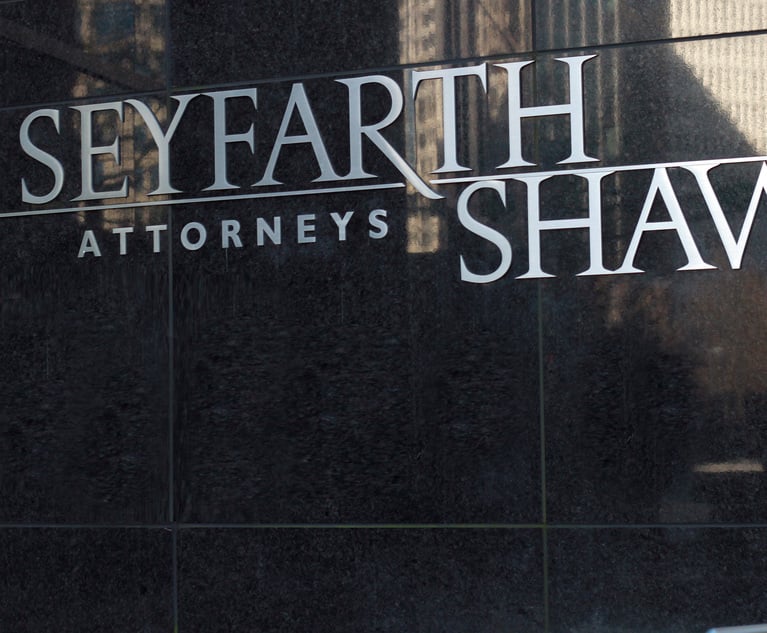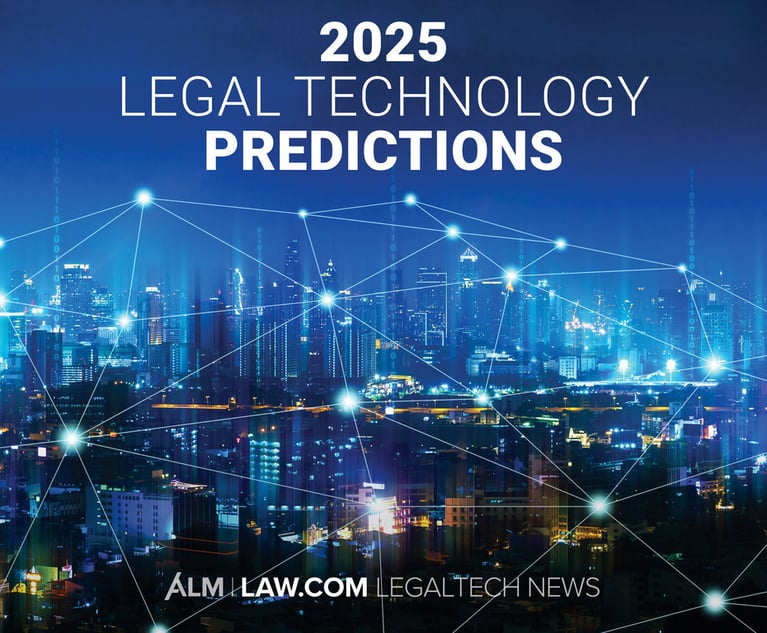 Kenneth Weatherwax of Lowenstein & Weatherwax (Photo: Courtesy Photo)
Kenneth Weatherwax of Lowenstein & Weatherwax (Photo: Courtesy Photo)'Alice' in the Looking-Glass
Years of confusion over what is “eligible” for patenting have weakened the U.S. patent system.
May 22, 2019 at 05:12 PM
6 minute read
To protect against pre-empting future innovation, some basic discoveries, no matter now useful, new, and nonobvious, have long been categorically excluded as “ineligible” for patenting in the United States: laws of nature, pure natural phenomena, and abstract ideas such as mathematical formulas. However, which ideas are too “abstract” to be eligible? Patents granted on inventions like methods of saving money on taxes have been widely criticized as bad law and bad policy. But what about other business methods? Database designs? Blockchain techniques?
In 2013 the Supreme Court stepped into the debate. And in Alice Corporation v. CLS Bank International, 573 U.S. 208, it held that ineligible “abstract ideas” include any inventions that form a “building block of the modern economy,” or “fundamental economic practice,” or similar concepts. Furthermore, the Court announced, only if such ideas are joined to an “inventive concept”—a limitation “sufficient to transform the claimed abstract idea into a patent-eligible application”—are they eligible even to be considered for patenting.
Alice was immediately seen as important, and triggered a nationwide explosion of challenges to patents in almost every area of technology. It was not a foregone conclusion how Alice's vaguely stated test would be interpreted, and for five years the courts and the Patent Office have struggled to do so. But the verdict is in. Hundreds of court and agency decisions, rulemakings, and law review articles later, the Supreme Court's decision in Alice has failed to yield an administrable, predictable and reliable test—yet has simultaneously created the most lethal attack on patents in modern memory. Hundreds of patents have been summarily struck down as “abstract” under Alice, but no one seems to know, particularly in technologies such as software and finance, what is and is not “patent-eligible.” This uncertainty is crippling the patent system. Like the “problem” patents Alice sought to limit, Alice itself is too abstract and too broad.
There are four main problems created by Alice. First, the courts have been unable to predictably apply it. Every idea is in some sense abstract. But courts have been unable to produce a workable definition of what makes ideas “abstract” or not in Alice's sense. Alice said its concern was “one of pre-emption”—the broad pre-emption of use of an idea “in all fields.” But courts applying Alice have rejected that as a limiting principle. The court that hears all U.S. patent appeals has flatly declared that under Alice “pre-emption is not the test for determining patent-eligibility,” and the fact that patents do not “pre-empt” an “entire field … does not make them any less abstract.” The Court has at other times rejected “tangibility,” “breadth,” and even “narrowness” as relevant to Alice. The confusion reached a pinnacle of absurdity in 2017 when a patent to an MRI machine—not a method of using an MRI machine, but the machine itself—was denied as too “abstract.”
Second, the courts have applied Alice's test not as dependent on the details of the technology or even the details of the patent claims, but as a question of law that can be decided at the very threshold, without trial, before discovery, and ignoring most of what the claim says. All the court must do is muse whether it thinks the technology is too “abstract” and whether the “inventive concept” is insufficient. And the courts, applying this unmoored test, have applied it in an unmoored way—striking down about two-thirds of the patents they have considered under Alice, with their explanations of how Alice applies usually leaving the reader none the wiser.
Many judges have gone on record lamenting that Alice is unworkable, and imploring Congress or the Supreme Court to replace or clarify it. Countless certiorari petitions have asked the Supreme Court to step back in; all have been denied. Congress has introduced bills; none has passed. Meanwhile, a law professor friend of mine has dropped eligibility from the curriculum of his patent law course—telling me and his students that he can no longer explain the decisions under Alice.
Third, the Alice test has made patent eligibility narrower in the United States than in the rest of the world. American patent lawyers tell stories of colleagues overseas who ask them wonderingly what in the world American courts think they are doing striking down patents that would survive in any other country. As the general counsel of the U.S. Federal Trade Commission recently remarked in a speech, “there are many other parts of the world that have more expansive views of what can be patented” than under Alice, and the great uncertainty it has caused is driving innovation overseas.
Fourth, and perhaps worst of all, even the U.S. Patent Office cannot reach agreement with the courts on what Alice means. The courts are not limiting themselves to striking down patents that issued before Alice. They are routinely striking down patents almost as soon as the Office issues them—even when the Office just expressly considered the patent under Alice and found it eligible. The Office has issued guidelines on what it thinks Alice means, and courts have almost immediately refused to accept those guidelines, calling them nonbinding and wrong. And strangest of all, the courts are routinely finding patents—even if just issued—so clearly ineligible under Alice that they are awarding the accused infringers sanctions, explaining that the fact that the Patent Office had just issued the patent over Alice cannot be relied upon as any objective basis to believe the patent is eligible. If that is true, how can any patent be trusted at all? What certainty remains?
The problem of too-broad patenting is very real. But five years of attempts to apply Alice's attempt to fix that problem have shown that its cure is worse than the disease. This uncertainty cannot continue. Intervention by Congress or the Supreme Court is urgently needed to clarify the law.
Kenneth Weatherwax is a patent litigator and co-founder of Lowenstein & Weatherwax LLP, which last year was ranked the best-performing law firm in the history of “inter partes review” proceedings before the U.S. Patent and Trademark Office. He no longer litigates patent eligibility.
This content has been archived. It is available through our partners, LexisNexis® and Bloomberg Law.
To view this content, please continue to their sites.
Not a Lexis Subscriber?
Subscribe Now
Not a Bloomberg Law Subscriber?
Subscribe Now
NOT FOR REPRINT
© 2025 ALM Global, LLC, All Rights Reserved. Request academic re-use from www.copyright.com. All other uses, submit a request to [email protected]. For more information visit Asset & Logo Licensing.
You Might Like
View All

New Year, New Am Law 100: Challenges Await These Newly Merged Law Firms
7 minute read
Trending Stories
- 1Restoring Trust in the Courts Starts in New York
- 2'Pull Back the Curtain': Ex-NFL Players Seek Discovery in Lawsuit Over League's Disability Plan
- 3Tensions Run High at Final Hearing Before Manhattan Congestion Pricing Takes Effect
- 4Improper Removal to Fed. Court Leads to $100K Bill for Blue Cross Blue Shield
- 5Michael Halpern, Beloved Key West Attorney, Dies at 72
Who Got The Work
Michael G. Bongiorno, Andrew Scott Dulberg and Elizabeth E. Driscoll from Wilmer Cutler Pickering Hale and Dorr have stepped in to represent Symbotic Inc., an A.I.-enabled technology platform that focuses on increasing supply chain efficiency, and other defendants in a pending shareholder derivative lawsuit. The case, filed Oct. 2 in Massachusetts District Court by the Brown Law Firm on behalf of Stephen Austen, accuses certain officers and directors of misleading investors in regard to Symbotic's potential for margin growth by failing to disclose that the company was not equipped to timely deploy its systems or manage expenses through project delays. The case, assigned to U.S. District Judge Nathaniel M. Gorton, is 1:24-cv-12522, Austen v. Cohen et al.
Who Got The Work
Edmund Polubinski and Marie Killmond of Davis Polk & Wardwell have entered appearances for data platform software development company MongoDB and other defendants in a pending shareholder derivative lawsuit. The action, filed Oct. 7 in New York Southern District Court by the Brown Law Firm, accuses the company's directors and/or officers of falsely expressing confidence in the company’s restructuring of its sales incentive plan and downplaying the severity of decreases in its upfront commitments. The case is 1:24-cv-07594, Roy v. Ittycheria et al.
Who Got The Work
Amy O. Bruchs and Kurt F. Ellison of Michael Best & Friedrich have entered appearances for Epic Systems Corp. in a pending employment discrimination lawsuit. The suit was filed Sept. 7 in Wisconsin Western District Court by Levine Eisberner LLC and Siri & Glimstad on behalf of a project manager who claims that he was wrongfully terminated after applying for a religious exemption to the defendant's COVID-19 vaccine mandate. The case, assigned to U.S. Magistrate Judge Anita Marie Boor, is 3:24-cv-00630, Secker, Nathan v. Epic Systems Corporation.
Who Got The Work
David X. Sullivan, Thomas J. Finn and Gregory A. Hall from McCarter & English have entered appearances for Sunrun Installation Services in a pending civil rights lawsuit. The complaint was filed Sept. 4 in Connecticut District Court by attorney Robert M. Berke on behalf of former employee George Edward Steins, who was arrested and charged with employing an unregistered home improvement salesperson. The complaint alleges that had Sunrun informed the Connecticut Department of Consumer Protection that the plaintiff's employment had ended in 2017 and that he no longer held Sunrun's home improvement contractor license, he would not have been hit with charges, which were dismissed in May 2024. The case, assigned to U.S. District Judge Jeffrey A. Meyer, is 3:24-cv-01423, Steins v. Sunrun, Inc. et al.
Who Got The Work
Greenberg Traurig shareholder Joshua L. Raskin has entered an appearance for boohoo.com UK Ltd. in a pending patent infringement lawsuit. The suit, filed Sept. 3 in Texas Eastern District Court by Rozier Hardt McDonough on behalf of Alto Dynamics, asserts five patents related to an online shopping platform. The case, assigned to U.S. District Judge Rodney Gilstrap, is 2:24-cv-00719, Alto Dynamics, LLC v. boohoo.com UK Limited.
Featured Firms
Law Offices of Gary Martin Hays & Associates, P.C.
(470) 294-1674
Law Offices of Mark E. Salomone
(857) 444-6468
Smith & Hassler
(713) 739-1250







